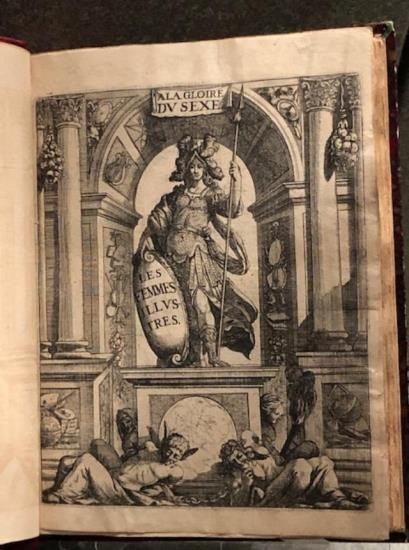 While viewing the Lisa Unger Baskin Collection at the Grolier Club, I pondered many interesting artifacts about the women’s suffrage movement. One of the many notable women who participated in the movement was a French philosopher and writer, Madeline de Scudery. Though she was proud of her work, she couldn’t publish her books and novels under her name due to patriarchal standards, so she wrote under her brother’s name instead. Her philosophical topics varied from gender and sexuality to education and power. Unfortunately, Scudery was dismissed by men, and critics paid her no mind. Her life revolved around defending women’s right to exercise political authority and inclusion to literary culture. “Les Femmes Illustres (The Illustrious Women)” serves as a powerful reminder of women’s impact not only in literary culture, but also in the upbringing of society. In the picture, a bold woman is shown standing on a platform with a shield in one hand and a large spear in the other. Below her are ill-looking men in chains, laid on the ground. Above the woman is a sign that says “Ala gloire du sexe (The glory of sex).” When focusing on the details, I noticed how masculine the woman’s leg looked. I immediately knew that the illustrator wanted us to understand that women are capable of doing the same things a man can do. One can claim that the artist felt women were superior to men because of how defeated the men look lying beneath the woman. Also, she stands very firm and robust in contrast to them, which furthers the claim. This photo packs a punch. At first glance I only saw the surface level aspects, but when I paid attention to the details of the photo such as the leg, the faces and the designs on the structures, it added more depth to the illustrator’s message. Reading about the history behind this book/illustration and others gave me a new found respect for the suffragists/suffragettes of the movement. Viewing the Lisa Unger Baskin collection was saddening but also empowering. These artifacts surrounding women’s journey to equality hold a lot of weight and strength. It reminds me to be grateful for the equality I now have and to honor those who’ve paved the way.
While viewing the Lisa Unger Baskin Collection at the Grolier Club, I pondered many interesting artifacts about the women’s suffrage movement. One of the many notable women who participated in the movement was a French philosopher and writer, Madeline de Scudery. Though she was proud of her work, she couldn’t publish her books and novels under her name due to patriarchal standards, so she wrote under her brother’s name instead. Her philosophical topics varied from gender and sexuality to education and power. Unfortunately, Scudery was dismissed by men, and critics paid her no mind. Her life revolved around defending women’s right to exercise political authority and inclusion to literary culture. “Les Femmes Illustres (The Illustrious Women)” serves as a powerful reminder of women’s impact not only in literary culture, but also in the upbringing of society. In the picture, a bold woman is shown standing on a platform with a shield in one hand and a large spear in the other. Below her are ill-looking men in chains, laid on the ground. Above the woman is a sign that says “Ala gloire du sexe (The glory of sex).” When focusing on the details, I noticed how masculine the woman’s leg looked. I immediately knew that the illustrator wanted us to understand that women are capable of doing the same things a man can do. One can claim that the artist felt women were superior to men because of how defeated the men look lying beneath the woman. Also, she stands very firm and robust in contrast to them, which furthers the claim. This photo packs a punch. At first glance I only saw the surface level aspects, but when I paid attention to the details of the photo such as the leg, the faces and the designs on the structures, it added more depth to the illustrator’s message. Reading about the history behind this book/illustration and others gave me a new found respect for the suffragists/suffragettes of the movement. Viewing the Lisa Unger Baskin collection was saddening but also empowering. These artifacts surrounding women’s journey to equality hold a lot of weight and strength. It reminds me to be grateful for the equality I now have and to honor those who’ve paved the way.






